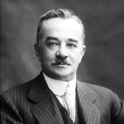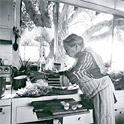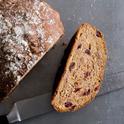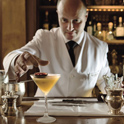When a French youngster decides that he wishes to become a chef, he may start his training in several ways. He might, for example, undertake an apprenticeship in a restaurant or a hotel kitchen. Then he will learn his trade in the fashion of that particular place. If the hotel is an expensive, elaborate city establishment, he will learn to prepare exotic foods. If he goes instead to a fine restaurant in the provinces, he will concentrate on the specialties of the region. Both these paths have obvious limitations. For example, in all probability neither of these kitchens will make its own pastry. and the young apprentice may never learn the techniques of that difficult art.
Or the young man who wishes to be a chef may do as I did, and begin his studies in a pastry shop of the sort which exists in every French community. There are an amazing number of such shops in France: in the boulangeries, or bakeries, the baker makes bread and rolls, the long, crusty flûtes which are typical of France, and the large, round loaf from which the baker will slice off a pound, or half a pound, to your order; in the pâtisseries, all the other baked products are made and sold. The pâtissier never has anything to do with bread. He makes the brioches, the savarins. the croissants, the various tarts, gâteaux, and petits fours. The larger pâtisseries also make vol-au-vents and patty shells, and the various elaborate forcemeats and pâtés to fill them In effect, they perform a kind of catering service, Just such a pastry shop was my first school —La Maison Calondre, in Moulins.
The doorway of La Maison Calondre was flanked by high, broad, sparkling windows in which rows of enticing pastries were displayed. Inside the shop, marble counters, mirrored panels framed in shining nickel plate, and marble-topped tables gave a turn-of-the-century elegance. In the rear of the shop was the huge laboratoire where we apprentices learned our lessons. Here were the high ovens, the gas-driven mixing machine, and the long work counters. This was the domain of Monsieur, just as the shop out front was that of Madame. Monsieur was a stein master, but a fair one. We worked very hard under Monsieur's watchful eye, as hard as if he had been paying us. instead of receiving substantial payment from our parents for his instruction.
Every kind of chef must have special skills. A roast chef, while he exercises constant vigilance and unimpeachable judgment about all his work, must know, as if by instinct, the very moment when his roasts are à point, perfectly cooked. A sauce chef must know when to simmer his sauces and when to reduce them quickly, and he must know which of dozens of ingredients to choose to enhance the perfection of flavor and texture in his sauce: wine, stock, cream, butter, or whatever.
But a pastry chef must have these skills and more; he must understand the right moment at which a dough should be shaped; he must know how to decorate tiny perils fours and great gâteaux, and he must be able to make hundreds of éelairs, macaroons, meringues, and lady fingers with hardly a variation in size, working with his pastry bag with amazing quickness. The pastry chef's work is most exacting because his ingredients must be accurately measured; numbers of eggs and cups of butter are not for him; he must weigh each ingredient painstakingly in kilos and grams. An apprenticeship as a pastry chef develops in a young man a meticulousness which serves him well when he goes on to learn other jobs in restaurants or in hotel kitchens.
As in all fields of cookery, when the fundamental rules and skills have been mastered, the variations are easy enough to learn. As it happened, I learned pastry making in no logical order; my apprenticeship was a working arrangement, and I began by making the baked products which were most in demand at that season, I will not confuse you by asking you to learn as I did, but will divide all pastry making into three classifications, the first of which, yeast dough, will be discussed in this article. The second classification will include éclairs, little cakes, most of the gâteaux, and the cream fillings that go with them. and the third part will discuss butter rich pastries, puff paste, tart pastes, and their variations.
If we are to begin with yeast doughs, we must first know what yeast is. Yeast is a living organism that grows when placed in a warm, moist mixture and creates bubbles of gas which make the mixture light. Excessive heat will kill yeast, and if the dough is allowed to rise too long it will fall and even turn sour. Yeast dough should be allowed to rise until ie doubles in bulk, and at this point it should be punched down or baked. In order to help the dough capture the gas and distribute it evenly through the mass, the mixture must be kneaded or beaten, and this process also makes the dough elastic and gives it what the French call du corps, or body.
There are two kinds of yeast on the market, the familiar foil-wrapped, moist cake, and the new granulated, dry yeast which comes in a sealed foil pack and does not have to be refrigerated. Both kinds work equally well, but experts recommend that the temperature of the water in which the dry yeast is dissolved be slightly warmer than that for the moist cake.
I should like in this article to tell you about the rich, light but not sweet French specialties. I will not go into the subject of breads, but I feel that once you have learned how to make brioches and croissants, ordinary bread and rolls will have no difficulty for you. Actually, in France, these are not usually made at home; pâtisseries, with their fine equipment and their practiced skill, do such a fine job that the home cook, in a Country where fuel is always a problem and good ovens an exception to the rule, prefers to leave this kind of backing to the professionals.



 Pinterest
Pinterest






